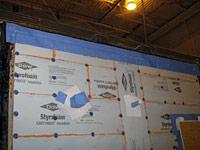Simple, Fast, Cost Effective Methods of Foam Board Joint Sealing for Air Barrier Assemblies in Commercial Construction

Air infiltration and exfiltration have long been recognized as significant sources of energy loss in both commercial and residential buildings. The most common method used to decrease air infiltration in opaque walls is the use of an air barrier product, which is typically an air impermeable sheet or film added over the entire wall surface.
Another method that can be used to reduce air infiltration in walls is to seal any joints or cracks in the wall. Since a continuous layer of plastic foam board insulation is a common element in many wall systems, the sealing of the insulation board joints to provide the desired air barrier qualities in a wall system is a viable method towards creating a more energy efficient building. This is especially useful when considering the increased reliance on continuous insulation that is emphasized in the American Society of Heating, Refrigerating, and Air-Conditioning Engineers (ASHRAE) 90.1-2010 Energy Standard for Buildings Except Low-Rise Residential Buildings and International Energy Conservation Code Council (IECC).
Two board joint sealing methods were developed and then tested to determine the resulting quality of their air barrier effectiveness. These methods include the use of tapes and sealants. The details of board joint sealing are discussed as well as the corresponding results of laboratory air barrier assembly testing. Both methods of joint sealing were tested using ASTM E2357 “Standard Test Method for Determining Leakage of Air Barrier Assemblies” and the resulting air leakage rate was below the levels specified by various building codes and industry standards. As a result, these methods may provide a simpler, faster, and yet cost effective approach to reduce air infiltration in wall systems.
More Like This
- Performance and Durability of Wall Assemblies using Mineral Wool Exterior Insulation in the Pacific Northwest
- Joining the Pieces Together: A New Weatherbarrier Sealant to Ensure Energy Retention of Commercial Buildings
- Inward Vapor Drives in Adhered Veneer Wall Assemblies with Continuous Exterior Insulation


Add comment
Log in to post comments